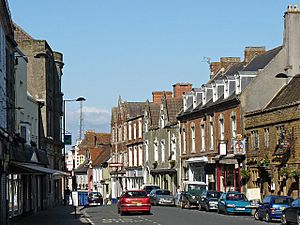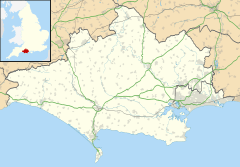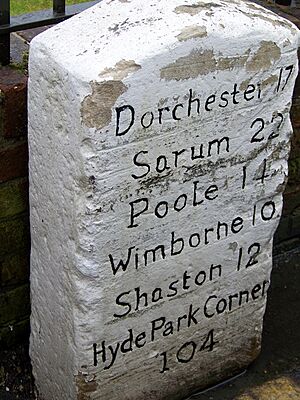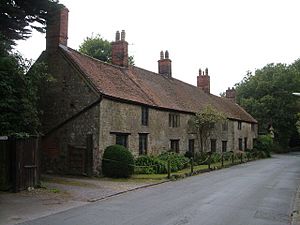Shaftesbury facts for kids
Quick facts for kids Shaftesbury |
|
|---|---|
 High Street |
|
 Coat of Arms of Shaftesbury |
|
| Population | 9,162 (2021 census) |
| OS grid reference | ST861228 |
| • London | 97 miles |
| Civil parish |
|
| Unitary authority |
|
| Ceremonial county | |
| Region | |
| Country | England |
| Sovereign state | United Kingdom |
| Post town | SHAFTESBURY |
| Postcode district | SP7 |
| Dialling code | 01747 |
| Police | Dorset |
| Fire | Dorset |
| Ambulance | South Western |
| EU Parliament | South West England |
| UK Parliament |
|
Shaftesbury is a town and civil parish in Dorset, England. It sits on the A30 road, about 20 miles (32 km) west of Salisbury and 23 miles (37 km) north-northeast of Dorchester. The town is close to the border with Wiltshire.
Shaftesbury is special because it's the only major town in Dorset built on a hilltop. It stands about 215 meters (705 feet) above sea level. The town is on a greensand hill, which is at the edge of Cranborne Chase. From Shaftesbury, you can look out over the Blackmore Vale, which is part of the River Stour area.
The town is home to the remains of Shaftesbury Abbey. This abbey was started in 888 by King Alfred. It grew to be one of the richest religious places in England. However, it was destroyed in 1539 during the Dissolution of the monasteries. Right next to the abbey site is Gold Hill. This is a very steep, cobbled street. It became famous in the 1970s from a TV advertisement for Hovis bread.
In the 2021 census, Shaftesbury had a population of 9,162 people.
Contents
What's in a Name?
Shaftesbury has had many names over time. In 1906, Sir Frederick Treves wrote about some of these names. They came from Celtic, Latin, and English traditions.
He mentioned that the town was first called Caer Palladour. Later, it was known as Sceptesberie in the Domesday Book. It also had a fancy name, Sophonia. Even today, some local people still call it Shaston. Old milestones around the area often show distances to "Shaston."
The very first Celtic name was Caer Vynnydd y Paladr. This means "The Mountain Fort/City of the Spears." Another old name, Caer Palladour, was recorded in 1709. Even though some thought "Palladour" was made up, it's still used as a poetic name for the town.
The English name was recorded as Sceptesberie in the Domesday Book of 1086. The name "Shaston" was noted in books from the 1830s and 1840s. The famous writer Thomas Hardy used both "Shaston" and "Palladour" in his novels. He used them to describe the town in his fictional region of Wessex.
Shaftesbury's Past
Shaftesbury's recorded history truly begins in Anglo-Saxon times. There is no strong proof it was a Celtic or Roman town. By the early 700s, an important church was here. In 880, Alfred the Great built a burgh here. A burgh was a fortified settlement. This was to defend against Danish invaders. Shaftesbury was one of only three such forts in Dorset at that time.

In 888, King Alfred founded Shaftesbury Abbey. This was a Benedictine nunnery (a place where nuns live). It was built near the town's east gate. Alfred's daughter, Ethelgifu, became its first leader, called an abbess. Later, King Æthelstan set up two royal mints in Shaftesbury. These mints made pennies with the town's name on them. The abbey became the richest Benedictine nunnery in all of England. On February 20, 981, the remains of St Edward the Martyr, a young English king, were brought to the abbey. This made Shaftesbury a very important place for people seeking healing miracles.
King Canute died in Shaftesbury in 1035. However, he was buried in Winchester. Edward the Confessor allowed a third mint to open in the town. By the time the Normans arrived in 1066, Shaftesbury had 257 houses. Many were destroyed during the fighting. When the Domesday Book was made 20 years later, only 177 houses remained. Still, Shaftesbury was the biggest town in Dorset at that time. During the first English civil war (1135–1154), a small castle was built. This castle was on a hill at the western edge of the old town. Today, this site is just grass and is a protected historical place.
In 1240, a church leader named Cardinal Otto of Tonengo visited the abbey. He confirmed an important document from 1191. During the Middle Ages, the abbey was the most important part of the town. People used to say that if the abbot of Glastonbury married the abbess of Shaftesbury, their child would own more land than the King of England! This shows how rich the abbey was. In 1260, the town was allowed to hold a market. By 1340, the mayor was an official figure, approved by the abbess. In 1392, Richard II confirmed that the town could hold two markets on different days. Edwardstowe, the oldest building still standing in Shaftesbury, was built between 1400 and 1539. A medieval farm owned by the Abbess was also set up where the Tesco supermarket car park is now.
In 1539, the last Abbess, Elizabeth Zouche, gave up the abbey. The very rich abbey was then pulled down. Its lands were sold off. This caused the town to decline for a while. Sir Thomas Arundell bought the abbey and much of the town in 1540. But he was later accused of treason, and his lands were taken away. The lands then passed to other important families.
Shaftesbury sent two members to Parliament from 1296. This changed to one member after the Reform Act of 1832. In 1884, it stopped being a separate voting area. Around 1630, a writer described Shaftesbury as a "fair Thorough Faire." This meant it was a busy place for travelers going to and from London.
During the English Civil War, Shaftesbury generally supported Parliament. However, it was controlled by the Royalists. Parliamentary forces surrounded the town in August 1645. At that time, it was a center for local "clubmen." These were groups of local people who tried to protect their areas. The clubmen were arrested. Shaftesbury did not take part in the Monmouth Rebellion of 1685.
In the 1600s, making cloth was part of Shaftesbury's economy. Much of this work was done at home, like a cottage industry. In the 1700s, the town made a rough white woollen cloth called 'swanskin'. This was used by fishermen and for uniforms. Making buttons also became important. But when the Industrial Revolution started, these industries declined. This led to people losing jobs, hunger, and many families moving away. About 350 families left for Canada. Making and selling malt and beer were also important in the 1600s and 1700s. Shaftesbury became known for its beer, like other Dorset towns.
However, the railways did not come directly to Shaftesbury. This affected the town's economy. In the 1800s, the brewing industry only served local areas. Towns with railways could transport their beer more cheaply. The population of Shaftesbury grew very little during the 1800s.
The town hall was built in 1837 by Earl Grosvenor. It replaced an older building that was pulled down to make High Street wider. It is now a Grade II listed building, meaning it's historically important. Shaftesbury Town Hall is next to the 15th-century St Peter's Church. This church is also a Grade II* listed building. The Westminster Memorial Hospital was built in the mid-1800s. It was funded by a gift from the wife of the Duke of Westminster.
In 1918, a large part of the town was sold off. It was bought by a group of people and then sold piece by piece. Most of Shaftesbury's buildings today are from the 1700s or later. The older Saxon and medieval buildings have not survived.
How Shaftesbury is Run
In the UK national parliament, Shaftesbury is part of the North Dorset voting area. Since 2015, Simon Hoare from the Conservative Party has represented this area.
Locally, Shaftesbury is managed by Dorset Council. This is a single authority that handles many services. Shaftesbury also has its own Town Council. This council looks after things like parks, sports areas, gardens, litter, markets, public toilets, and the town hall. They also help with crime prevention and local events. The Town Council also gives advice on planning.
Shaftesbury is part of an electoral ward called Shaftesbury Town. This ward chooses two members to represent it on Dorset Council.
Shaftesbury's Location
The old center of Shaftesbury is on a high piece of land in northeast Dorset. It's on the edge of a range of hills that stretch into Cranborne Chase and Wiltshire. The town's built-up area goes down the slopes to lower areas. It also spreads eastwards across the hilltop.
Shaftesbury's height varies. The lowest streets are about 165 meters (541 feet) high. The highest point is about 235 meters (771 feet) at Wincombe Business Park. The town center itself is around 215 meters (705 feet) high. Below the town to the west is the Blackmore Vale. This area is between about 60 and 110 meters (197 and 361 feet) high. About 2 miles (3 km) west of town is Duncliffe Hill. This hill is shaped like a cone and can be seen from far away. It has a wood and a nature reserve. The countryside east of Shaftesbury is part of the Cranborne Chase and West Wiltshire Downs Area of Outstanding Natural Beauty.
The hill Shaftesbury is on is mostly made of Upper Greensand. This is covered by Lower Chalk in the east. These rocks formed millions of years ago. The greensand has three layers. The lowest layer is Cann Sand, found in the lower parts of town. Above this is Shaftesbury Sandstone, which forms the steepest slopes. On top is Boyne Hollow Chert, where most of the town is built.
Working in Shaftesbury
In 2012, about 3,400 people worked in Shaftesbury. Most of them (65%) worked full-time. The most important job areas were public services, education, and health. Production and construction were also big employers. Many people also worked in shops, hotels, and restaurants.
Some major employers in Shaftesbury include Dorset County Council, Pork Farms, and Guys Marsh Prison. Other companies like Royal Mail, Tesco, and Port Regis School also employ many people. The town has two industrial estates. These are areas with many businesses and factories.
In 2005, Shaftesbury had 75 shops. The town's shops serve people living up to about 4.5 miles (7 km) away. Big national shops like Boots, Superdrug, Tesco, and WHSmith have stores here.
There are plans for a new train station near the town. It would be north of Shaftesbury, below the A350 road. A bus service would connect it to the town. Right now, the closest train station is in Gillingham.
Shaftesbury's People
In the 2011 census, Shaftesbury had 3,493 homes. There were 3,235 households and a population of 7,314 people. The average age of people living in Shaftesbury was 43. This is older than the average age for England, which was 39.3. About 22.1% of people were 65 or older. This is higher than the 16.4% for England. Most of Shaftesbury's residents (92%) were born in the United Kingdom. This is also higher than the 86.2% for England as a whole.
The table below shows how the population of Shaftesbury has changed over the years:
| Census Population of Shaftesbury Parish 1921—2021 (except 1941) | ||||||||||||||
|---|---|---|---|---|---|---|---|---|---|---|---|---|---|---|
| Census | 1921 | 1931 | 1951 | 1961 | 1971 | 1981 | 1991 | 2001 | 2011 | 2021 | ||||
| Population | *1,812 | *2,819 | *3,303 | 3,372 | 3,980 | 3,940 | 6,180 | 6,680 | 7,314 | 9,162 | ||||
| Asterisks (*) indicate a boundary change Source:Dorset County Council |
||||||||||||||
Fun Things to Do and See
Shaftesbury Arts Centre started in 1957. It holds many art shows, performances, and workshops. It's located in the old covered market in the town center. Volunteers run the center.
Shaftesbury has two museums. Gold Hill Museum is at the top of Gold Hill. Shaftesbury Abbey Museum is in the abbey grounds. Gold Hill Museum opened in 1946. It shows many items about Shaftesbury's history. This includes Dorset's oldest fire engine, from 1744. Shaftesbury Abbey Museum tells the story of the abbey. It also has a herb garden and a medieval orchard.
Shaftesbury Snowdrops is a special project. It aims to create walking paths filled with snowdrops. These are beautiful white flowers that bloom in winter. The project started in 2012 by planting 60,000 bulbs. Since 2013, there has been an annual Snowdrop Festival. This festival encourages tourists to see the flowers. It includes a Snowdrop Art Exhibition and a Lantern Parade. In 2014, Shaftesbury Snowdrops began collecting rare snowdrops. These are shown at Shaftesbury Abbey during the festival.
The Gold Hill Fair usually happens on the first weekend of July. It has food stalls, art stalls, and local music. You can find these in the abbey ruins.
In 2016, Shaftesbury held its first open arts fringe festival. This festival has grown a lot. It is now one of the main fringe festivals in the country. It takes place on the first weekend in July. It brings together many different performers, from local singers to famous comedians.
Local news and TV shows come from BBC West and ITV West Country. Shaftesbury's local radio stations are BBC Radio Solent, Vale FM, and Heart West Country. The town also has a volunteer-run community radio station called Alfred. It broadcasts local news, talks, and music on 107.3 FM and online. It started as a weekly podcast and became daily during the COVID-19 pandemic.
Shaftesbury in Stories
Thomas Hardy used the names Shaston or Palladour for Shaftesbury in his fictional Wessex. In his book Jude the Obscure, he wrote about how the town had lost its old beautiful buildings, especially the abbey. He described how the thought of its old castles, mints, and churches, all now gone, made visitors feel sad.
In the 1970s, director Ridley Scott used Gold Hill for a TV advertisement. It was for Hovis bread. The ad showed a boy pushing his bicycle up the steep, cobbled street. Then he rode back down. This advertisement made the street famous across the country.
Getting Around Shaftesbury
Shaftesbury is on the A30 road, which connects Salisbury and Yeovil. It's also on the A350 road, linking Poole and Chippenham. The town is about 7 miles (11 km) south of the main A303 road. This road goes between London and South West England.
Shaftesbury has never had its own direct train station. Building a railway up the steep hills would have been very hard and expensive. In 1859, the Salisbury and Yeovil Railway opened a station at Semley. This was about 2.5 miles (4 km) north of Shaftesbury. This station allowed people to travel by train.
Semley station closed in 1966. This was part of the Beeching cuts, which closed many railway lines. Today, the closest train station to Shaftesbury is Gillingham railway station (Dorset). It's about 4 miles (6 km) northwest of the town. This station is on the West of England line, which goes from London Waterloo to Exeter.
Local bus services connect Shaftesbury to nearby villages and towns.
Town Facilities
Shaftesbury has a non-League football club called Shaftesbury F.C.. They play at Cockrams. The Shaftesbury Lido is an outdoor swimming pool at Barton Hill. It is open during the summer months.
The town also has a community hospital. It opened in 1874 and is called Westminster Memorial Hospital. It was named after the Marquis of Westminster. His widow gave the land for the hospital. Shaftesbury also has a public library, run by Dorset Council.
Famous People from Shaftesbury
- Cnut the Great, a powerful King of England, Denmark, and Norway, died in Shaftesbury in 1035.
- Poet William Chamberlayne lived his whole life in Shaftesbury (1619–1689).
- Philosopher Anthony Ashley-Cooper, 3rd Earl of Shaftesbury (1671–1713) was an important thinker about art and beauty.
- Actor Robert Newton was born here. He was famous for playing Long John Silver and Bill Sikes.
- Actor Ernie Bourne, known for TV shows like Blue Heelers and Neighbours, was born in Shaftesbury in 1926.
- Architect Richard Upjohn was born in Shaftesbury. He designed many famous churches in the United States.
- Electronic music producer Seamus Malliagh, known as Iglooghost, grew up in Shaftesbury.
- Electronic music producer and artist Kai Whiston also grew up in Shaftesbury.
- Lavinia Young (1911–1986) was born in Bimport. She became Mayor of Shaftesbury in 1970. She was also the Matron of Westminster Hospital in London.
- Johnnie Walker (DJ), a famous BBC Radio DJ, lived in St James.
See also
 In Spanish: Shaftesbury para niños
In Spanish: Shaftesbury para niños








